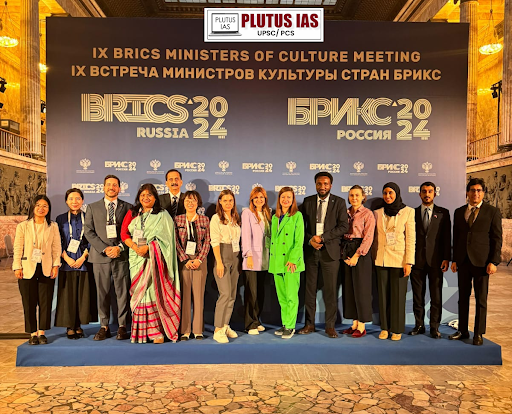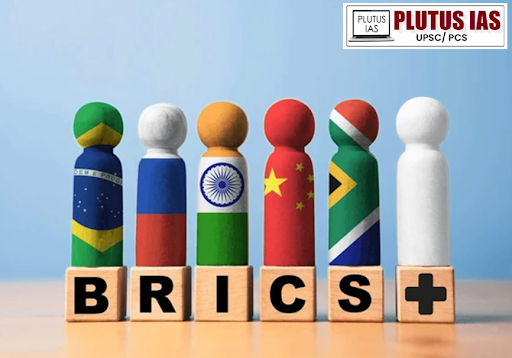16 Sep “The Rise of the East: BRICS as a Emerging Global Order and India’s Pivotal Role”
This article covers “Daily Current Affairs” and topic details of the RISE OF BRICS as an alternative global order and its challenges.
Syllabus mapping:
GS-2: International Relationship: India and regional grouping.
For Prelims:
What are NDB, BRICS+, and Contingent Reserve Arrangement?
For Mains:
What is the significance of the BRICS for India and how it can act as an alternative global economic order, what challenges and ways to make BRICS an alternative system? India and BRICS relations, its significance to India.
Why in the News?
An Indian delegation under the chairmanship of the Secretary of the Ministry of Culture attended the 9th BRICS Culture Ministers’ Meeting in St. Petersburg, Russia.

Introduction to BRICS
Origins and Formation:
2001: The term BRIC was coined in 2001 by Goldman Sachs to forecast global economic trends.
2006: The BRIC forum was formally established with a Foreign Ministers’ meeting in 2006.
2009: The first summit was held in Yekaterinburg, Russia, in 2009.
2010: South Africa joined in December 2010, leading to the formation of BRICS.
2024: BRICS PLUS: The expansion of BRICS, incorporating Iran, Egypt, Ethiopia, Saudi Arabia, and the UAE from January 2024 is called the BRICS+.
Key Institutions and Initiatives: New Development Bank (NDB) 2014, Contingent Reserve Arrangement (CRA), BRICS Business Council, BRICS Think Tanks Council.

Significance of the BRICS
1. Integration of New Members: The addition of new members from across the continents represents the BRICS support for enhancing the group’s diversity and influence.
2. Support for Multilateralism: Emphasizing a commitment to multilateralism and the UN Charter, BRICS underlines the central role of the United Nations in maintaining peace, advancing development, and promoting democracy and human rights.
3. Global Governance Reform: BRICS advocates for a more agile and representative international system that includes developing and least-developed countries, particularly from Africa, in global decision-making processes.
4. Economic importance: BRICS countries represent 26% of the global landmass and 42% of the global population which makes the BRICS far larger than the other groupings.
5. Multilateral Trading System: BRICS supports a fair, rules-based multilateral trading system with the WTO at its core, emphasizing the need for WTO reform.
6. Climate change fight: The group supports balanced energy transitions, utilizing all energy sources—including renewables, fossil fuels, and nuclear energy—to ensure resilient and sustainable energy systems.
7. Global Financial Architecture Reform: BRICS calls for reform of global financial institutions to enhance the voice and representation of developing countries. The NDB is mainly for this purpose.
8. Conflict Resolution: one of the significance is to reduce the tensions and bilateral issues among the members of The BRICS and call for the resolution of the international conflict.
Significance of the BRICS for India:
1. Economic Significance: The BRICS offers India a good opportunity to enhance its trade relations, and increase FDI flow in India.
2. Infrastructure and social development: The NDB provides India with financial resources for infrastructure projects, sustainable development, and other critical investments. This bank supports India’s economic development goals and infrastructure needs.
3. Cultural and Creative Industries in BRICS: India’s advocacy for including cultural and creative industries in BRICS’s agenda highlights the broader trend of recognizing culture as a driver of economic development.
4. Shaping the Global Development Agenda: In the past, India has used this platform for shaping the global Agenda.
5. Strengthening Multilateralism: India is an advocate of strengthening the UN and other multilateral bodies. This platform provides the voice for India to reform and strengthen the multilateral institutions.
6. Strategic Partnerships: BRICS helps India to build strategic partnerships with major global players, enhancing its influence in global affairs. Especially Russia.
7. Regional power: BRICS offers India an advantage to deal with issues such as terrorism and regional security etc. BRICS countries collaborated to provide the COVID-19 vaccine to developing and African countries.
8: Strategic autonomy: India is a member of the Quad and BRICS, both these groups are symbols of India’s strategic autonomy which helps India to protect its national interest.
Challenges for BRICS:
1. Aligning Diverse Interests: One of the primary challenges for BRICS is aligning the diverse interests of its members. China is more focused on economic integration, Russia is on the expansion of its defense exports, etc.
2. Managing Regional Rivalries: The inclusion of both Saudi Arabia and Iran in recent expansion, with their historical rivalries, could pose challenges to internal cohesion and decision-making within BRICS.
3. Overlap with Other Groupings: Managing mandates with other groupings like IBSA and SCO is also a challenge for the BRICS countries.
4. Leadership Contest: The expansion of BRICS has intensified the competition between China and India for leadership within the group and the Global South.
5. Domestic issues: The domestic political structure of the BRICS and BRICS countries is one of the challenges highlighted by C Raja Mohan.
6. Limited economic cooperation: The trade between BRICS nations is unequal. India has a trade deficit with China, and Russia and India have limited economic cooperation.
7. Regional issues: There are different perspectives of the BRICS countries on many regional issues such as China is actively engaging with the Taliban, unlike other BRICS countries.
Ways to utilize the BRICS potential:
1. Balancing the national interest: The diverse interests can be managed by the effective dialogue in the BRICS, Use this platform for the resolution of bilateral issues.
2. Enhancing economic cooperation: the exploration of the untapped potential between the BRICS countries can make a very large market. For example, India, and Russia.
3. Role of The NDB: The NDB can finance more projects in Africa and newly added members to make other developing countries join this organization.
4. Cooperation in technical and functional areas: The areas like health education and innovation, most of the BRICS countries can collaborate on this front. India opening an education centre in the UAE is the best move in this direction.
5. Respecting mutual concerns: countries should respect each other’s sovereignty and mutual interest, specifically bordering countries.
6. Cooperation in climate change and other global issues: the group becomes more effective when it raises the same voice for any issues. The BRICS countries can collaborate on issues like climate change and the transition to renewable energy.
7. Cultural Diplomacy: Promote cultural exchanges to build mutual understanding and respect among BRICS nations, thereby enhancing people-to-people connections and shared values.
8. Collaborative Security Frameworks: Develop cooperative security measures and intelligence-sharing frameworks to effectively address common security threats and challenges within the BRICS region.
9. Joint Counterterrorism Initiatives: Work together on counterterrorism and cybersecurity efforts to safeguard national and regional security interests from evolving threats.
Conclusion:
BRICS, initially focused on economic collaboration, has evolved to address a wide range of global issues through various summits and practical cooperation. The recent cultural summit and the addition of new members will boost the significance of the BRICS group. The role of India in adding new members once again highlights India’s active engagement in the group. The need to address mutual concerns, respect mutual interests, and work together for global challenges would help the group to stand as a complementary system of global governance.
Download plutus ias current affairs eng med 16th Sep 2024
PRELIMS QUESTION:
Q. Contingent Reserve Arrangement (CRA), recently often seen in the news in the context of which of the following:
A. BRICS
B. WEF
C. IMF
D. World Bank
ANSWER: A
MAINS QUESTION:
Discuss the Recent Expansion of BRICS to BRICS Plus and Highlight the Rise of BRICS as an Alternative Global Political Order. How Can India Play a Significant Role in This Emerging Global Order?
(250 words 15 marks)




No Comments